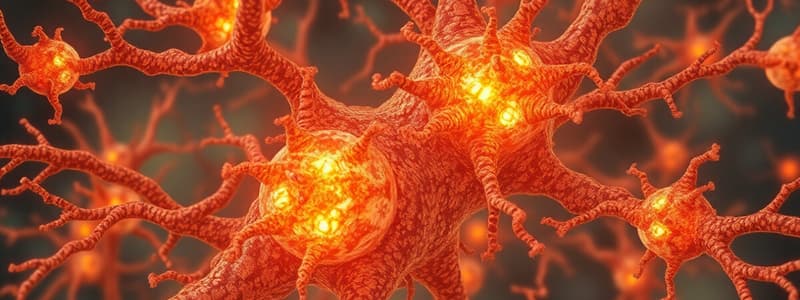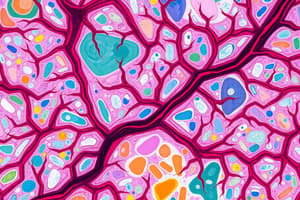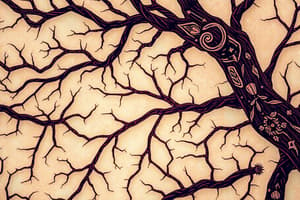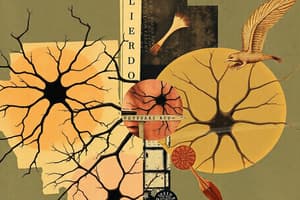Podcast
Questions and Answers
How does the distribution of Nissl substance within a neuron relate to its function?
How does the distribution of Nissl substance within a neuron relate to its function?
- Neurons with abundant Nissl substance indicate a high level of metabolic activity associated with protein synthesis. (correct)
- Neurons with less Nissl substance are more efficient at protein synthesis required for neurotransmitter production.
- The quantity of Nissl substance directly correlates with the neuron's ability to conduct action potentials.
- Neurons with more Nissl substance are specialized for sensory reception.
In the context of neuronal morphology, what functional implication can be derived from a neuron exhibiting a highly elaborate dendritic arborization?
In the context of neuronal morphology, what functional implication can be derived from a neuron exhibiting a highly elaborate dendritic arborization?
- Increased capacity for integration of incoming signals from multiple sources. (correct)
- Enhanced capacity for signal transmission, facilitating faster action potential propagation.
- Increased propensity for apoptosis due to the energy demands of maintaining the extensive dendritic structure.
- Reduced capacity for integration of incoming signals due to signal interference.
A researcher is examining a neuron under a microscope and observes a distinct lack of a clearly defined axon hillock. How might this observation influence the classification of the neuron?
A researcher is examining a neuron under a microscope and observes a distinct lack of a clearly defined axon hillock. How might this observation influence the classification of the neuron?
- It indicates the neuron is likely a projection neuron with a long axon.
- It confirms the neuron's classification as a sensory neuron.
- It definitively classifies the neuron as a motor neuron in the spinal cord.
- It suggests the neuron might be an anaxonic interneuron. (correct)
If a researcher discovers that a particular neuron type in the human brain lacks the protein MAP2, how would this impact the neuron's function and morphology?
If a researcher discovers that a particular neuron type in the human brain lacks the protein MAP2, how would this impact the neuron's function and morphology?
Which structural adaptation would most effectively enhance the speed of action potential propagation along a neuron's axon?
Which structural adaptation would most effectively enhance the speed of action potential propagation along a neuron's axon?
How do the unique structural features of Purkinje neurons contribute to their specialized role in cerebellar function?
How do the unique structural features of Purkinje neurons contribute to their specialized role in cerebellar function?
How might the dysregulation of astrocyte activity contribute to the pathogenesis of neurodegenerative diseases?
How might the dysregulation of astrocyte activity contribute to the pathogenesis of neurodegenerative diseases?
What is the functional significance of the unique morphology of microglia within the CNS?
What is the functional significance of the unique morphology of microglia within the CNS?
How does the arrangement of ependymal cells lining the ventricles of the brain contribute to the overall health and function of the CNS?
How does the arrangement of ependymal cells lining the ventricles of the brain contribute to the overall health and function of the CNS?
Which cellular mechanism primarily underlies the ability of oligodendrocytes to myelinate multiple axons within the central nervous system?
Which cellular mechanism primarily underlies the ability of oligodendrocytes to myelinate multiple axons within the central nervous system?
In the context of the blood-brain barrier, what specific structural adaptation of astrocytes facilitates their role in regulating vascular permeability?
In the context of the blood-brain barrier, what specific structural adaptation of astrocytes facilitates their role in regulating vascular permeability?
How does the histological composition of the cerebral cortex differ from that of the cerebellar cortex, and how does this contribute to functional specialization?
How does the histological composition of the cerebral cortex differ from that of the cerebellar cortex, and how does this contribute to functional specialization?
What functional implications arise from the cytoarchitectural organization of the cerebral cortex into distinct layers?
What functional implications arise from the cytoarchitectural organization of the cerebral cortex into distinct layers?
A pathological analysis of the spinal cord reveals significant damage to the dorsal horns, but the ventral horns appear relatively intact. What functional deficits would most likely be observed in a patient with this type of injury?
A pathological analysis of the spinal cord reveals significant damage to the dorsal horns, but the ventral horns appear relatively intact. What functional deficits would most likely be observed in a patient with this type of injury?
A researcher aims to evaluate the integrity of the blood-brain barrier (BBB) in a mouse model of stroke using immunohistochemistry. Which marker would be most appropriate for assessing the BBB's structural and functional status?
A researcher aims to evaluate the integrity of the blood-brain barrier (BBB) in a mouse model of stroke using immunohistochemistry. Which marker would be most appropriate for assessing the BBB's structural and functional status?
How do Schwann cells facilitate nerve regeneration in the peripheral nervous system following injury?
How do Schwann cells facilitate nerve regeneration in the peripheral nervous system following injury?
What is the primary distinction between spinal ganglia and autonomic ganglia in terms of their cellular composition and functional role?
What is the primary distinction between spinal ganglia and autonomic ganglia in terms of their cellular composition and functional role?
How do myelinated and unmyelinated nerve fibers structurally differ, and what are the functional consequences of these differences in the peripheral nervous system?
How do myelinated and unmyelinated nerve fibers structurally differ, and what are the functional consequences of these differences in the peripheral nervous system?
How does the connective tissue organization in peripheral nerves contribute to their ability to withstand mechanical stress and support axonal function?
How does the connective tissue organization in peripheral nerves contribute to their ability to withstand mechanical stress and support axonal function?
If a toxin selectively targets and disrupts the function of satellite cells within peripheral ganglia, what specific physiological processes would be most directly affected?
If a toxin selectively targets and disrupts the function of satellite cells within peripheral ganglia, what specific physiological processes would be most directly affected?
In nervous tissue, demyelination disrupts saltatory conduction by directly affecting which of the following structures?
In nervous tissue, demyelination disrupts saltatory conduction by directly affecting which of the following structures?
What would be the outcome if a drug inhibits the function of astrocytes?
What would be the outcome if a drug inhibits the function of astrocytes?
Increased white matter in the central nervous system affects primarily what function?
Increased white matter in the central nervous system affects primarily what function?
What characterizes the layers of the cerebral cortex?
What characterizes the layers of the cerebral cortex?
What feature is unique to cerebellar cortex?
What feature is unique to cerebellar cortex?
If the dorsal horns were damaged in the spinal cord, which deficits may occur?
If the dorsal horns were damaged in the spinal cord, which deficits may occur?
Which of the following describes the main components of a peripheral nerve?
Which of the following describes the main components of a peripheral nerve?
What role do satellite cells play in the peripheral nervous system (PNS)?
What role do satellite cells play in the peripheral nervous system (PNS)?
What distinguishes myelinated from unmyelinated nerve fibers? What feature is only found among myelinated nerve fibers?
What distinguishes myelinated from unmyelinated nerve fibers? What feature is only found among myelinated nerve fibers?
Which layer primarily determines the tensile strength and elasticity of peripheral nerves?
Which layer primarily determines the tensile strength and elasticity of peripheral nerves?
A neuron in the cerebral cortex is damaged and can no longer communicate with adjacent neurons. What is likely to occur?
A neuron in the cerebral cortex is damaged and can no longer communicate with adjacent neurons. What is likely to occur?
Within which part of the central nervous system (CNS) does interneuron primarily regulate excitatory signals?
Within which part of the central nervous system (CNS) does interneuron primarily regulate excitatory signals?
What is the main role of ependymal cells?
What is the main role of ependymal cells?
How is white matter in the brain organized compared to the spinal cord?
How is white matter in the brain organized compared to the spinal cord?
How does the cytoarchitecture of the cerebral cortex affect function?
How does the cytoarchitecture of the cerebral cortex affect function?
How does the unique arrangement of layers in the cerebral cortex contribute to its complex function in higher-order processing?
How does the unique arrangement of layers in the cerebral cortex contribute to its complex function in higher-order processing?
Which cellular component is most crucial for the unique signal integration capabilities observed in Purkinje neurons of the cerebellar cortex?
Which cellular component is most crucial for the unique signal integration capabilities observed in Purkinje neurons of the cerebellar cortex?
How does the cytoarchitecture of the spinal cord's gray matter contribute to its role in processing sensory and motor information?
How does the cytoarchitecture of the spinal cord's gray matter contribute to its role in processing sensory and motor information?
In the context of the blood-brain barrier (BBB), how do astrocytes contribute to the selective permeability that protects the central nervous system?
In the context of the blood-brain barrier (BBB), how do astrocytes contribute to the selective permeability that protects the central nervous system?
What mechanisms allow oligodendrocytes to provide myelin insulation to multiple axons simultaneously?
What mechanisms allow oligodendrocytes to provide myelin insulation to multiple axons simultaneously?
How does the unique morphology of microglia enable them to effectively fulfill their role as immune sentinels within the CNS?
How does the unique morphology of microglia enable them to effectively fulfill their role as immune sentinels within the CNS?
What structural adaptation in neurons would most effectively increase action potential propagation speed along long axons?
What structural adaptation in neurons would most effectively increase action potential propagation speed along long axons?
What functional consequences would directly arise from the selective disruption of ependymal cell function lining the brain's ventricles?
What functional consequences would directly arise from the selective disruption of ependymal cell function lining the brain's ventricles?
How do changes in astrocyte activity lead to the onset and progression of neurodegenerative diseases?
How do changes in astrocyte activity lead to the onset and progression of neurodegenerative diseases?
What is the functional outcome of selectively inhibiting satellite glial cells within the peripheral nervous system?
What is the functional outcome of selectively inhibiting satellite glial cells within the peripheral nervous system?
Which structural feature primarily facilitates the regeneration of damaged axons in the peripheral nervous system by Schwann cells?
Which structural feature primarily facilitates the regeneration of damaged axons in the peripheral nervous system by Schwann cells?
What is the key structural difference between spinal ganglia and autonomic ganglia that underlies their distinct functional roles?
What is the key structural difference between spinal ganglia and autonomic ganglia that underlies their distinct functional roles?
How does the connective tissue organization within peripheral nerves enhance their resilience to mechanical stress and facilitate optimal axonal function?
How does the connective tissue organization within peripheral nerves enhance their resilience to mechanical stress and facilitate optimal axonal function?
What mechanism underlies saltatory conduction in myelinated nerve fibers?
What mechanism underlies saltatory conduction in myelinated nerve fibers?
What impact would a drug inhibiting astrocyte function have on neural activity and synaptic transmission?
What impact would a drug inhibiting astrocyte function have on neural activity and synaptic transmission?
Which statement accurately contrasts the organization of white matter in the brain versus the spinal cord?
Which statement accurately contrasts the organization of white matter in the brain versus the spinal cord?
What is the main function of the Nissl substance in neurons?
What is the main function of the Nissl substance in neurons?
If a neural injury damaged the dorsal horns of the spinal cord, what primary functional loss would occur?
If a neural injury damaged the dorsal horns of the spinal cord, what primary functional loss would occur?
How do myelinated and unmyelinated nerve fibers differ at the microscopic level?
How do myelinated and unmyelinated nerve fibers differ at the microscopic level?
If a toxin disrupted the function of satellite cells of the PNS, what functions would be most likely affected?
If a toxin disrupted the function of satellite cells of the PNS, what functions would be most likely affected?
How does the presence of increased white matter affect the efficiency of nervous tissue function?
How does the presence of increased white matter affect the efficiency of nervous tissue function?
What occurs within the nervous system if a neuron within the cerebral cortex is damaged and unable to communicate with adjacent neurons?
What occurs within the nervous system if a neuron within the cerebral cortex is damaged and unable to communicate with adjacent neurons?
What are the functional and structural differences between a nerve and a tract within nervous tissue?
What are the functional and structural differences between a nerve and a tract within nervous tissue?
What is the function of the lipoidal substance that covers nerve fibers in the central and peripheral nervous systems?
What is the function of the lipoidal substance that covers nerve fibers in the central and peripheral nervous systems?
What is similar to rough endoplasmic reticulum in neurons?
What is similar to rough endoplasmic reticulum in neurons?
Flashcards
What is a neuron?
What is a neuron?
A nerve cell that is the basic building block of the nervous system.
What are dendrites?
What are dendrites?
Branchlike parts of a neuron that are specialized to receive information.
What is an axon?
What is an axon?
A long, thin fiber that transmits signals away from the neuron cell body to other neurons, or to muscles or glands.
What is the Axon hillock?
What is the Axon hillock?
Signup and view all the flashcards
What is Nissl substance?
What is Nissl substance?
Signup and view all the flashcards
What are glial cells?
What are glial cells?
Signup and view all the flashcards
What is a synapse?
What is a synapse?
Signup and view all the flashcards
What are Oligodendrocytes?
What are Oligodendrocytes?
Signup and view all the flashcards
What are Microglia?
What are Microglia?
Signup and view all the flashcards
What are Ependymal cells?
What are Ependymal cells?
Signup and view all the flashcards
What is Dura Mater?
What is Dura Mater?
Signup and view all the flashcards
What is Arachnoid Mater?
What is Arachnoid Mater?
Signup and view all the flashcards
What is the Pia Mater?
What is the Pia Mater?
Signup and view all the flashcards
What is White Matter?
What is White Matter?
Signup and view all the flashcards
What is Gray Matter?
What is Gray Matter?
Signup and view all the flashcards
What is the Cerebral Cortex?
What is the Cerebral Cortex?
Signup and view all the flashcards
What is the Cerebellum?
What is the Cerebellum?
Signup and view all the flashcards
What is the H-shaped gray Matter?
What is the H-shaped gray Matter?
Signup and view all the flashcards
What is the White Matter?
What is the White Matter?
Signup and view all the flashcards
What is the Peripheral Nervous System (PNS)?
What is the Peripheral Nervous System (PNS)?
Signup and view all the flashcards
What are Schwann cells?
What are Schwann cells?
Signup and view all the flashcards
What are satellite cells?
What are satellite cells?
Signup and view all the flashcards
What is the Epineurium?
What is the Epineurium?
Signup and view all the flashcards
What is the Perineurium?
What is the Perineurium?
Signup and view all the flashcards
What is the Endoneurium?
What is the Endoneurium?
Signup and view all the flashcards
What are myelinated nerve fibers?
What are myelinated nerve fibers?
Signup and view all the flashcards
What are unmyelinated nerve fibers?
What are unmyelinated nerve fibers?
Signup and view all the flashcards
Study Notes
- MT120225 Histology (Laboratory) covers nervous tissue in Unit 4.
- The second semester of the A.Y. 2024-2025 has been set for the lectures.
- The topic outline includes an overview of the nervous system tissue, the central and peripheral nervous systems, and laboratory activities and reviews.
- At the end of the exercise, students should have the required skills
- Students should be able to differentiate neuron types according to structure at the end of the lesson.
- Identify neuroglial cells in the CNS and PNS.
- Distinguish the main regions of the brain and spinal cord based on location and structures.
- Identify cerebellum histologic layers.
- Microscopically differentiate myelinated and unmyelinated nerve fibers.
Morphology of a Typical Neuron
- Neurons are the key cells in nervous tissue
Neuron Classifications
- Neurons are classified according to their structure
- Pseudounipolar or unipolar neurons have a single process that splits into two branches.
- Bipolar neurons have one axon and one dendrite.
- Multipolar neurons have one axon and multiple dendrites.
Synapse
- Synapses are structures that allow neurons to pass signals to other neurons.
Central Neuroglia Types
- Astrocytes
- Oligodendrocytes
- Microglia
- Ependymal cells
Astrocytes
- Can be protoplasmic or fibrous.
- Immunohistochemical staining of astrocytes in brain white matter uses anti-GFAP antibodies.
Meningeal Layers
- The CNS has three connective tissue layers, Dura Mater, Arachnoid mater, and Pia Mater.
- Dura mater (outermost) is thick, dense, irregular connective tissue continuous with the periosteum of the skull.
- Arachnoid mater (middle) has two components (1) a sheet of connective tissue in contact with the dura mater, and (2) a system of loosely arranged trabeculae continuous with the pia mater.
- Pia mater (innermost) consists of flattened mesenchymal-derived cells.
Central Nervous System Structures
- The central nervous system includes white matter and gray matter
- White matter consists mostly of myelinated nerve fibers plus some unmyelinated fibers and glial cells.
- Gray matter comprises neuronal cell bodies, unmyelinated fibers, and neuroglial cells.
Cerebrum
- A key part of the central nervous system
Cerebral Cortex
- Cerebral cortex layers include molecular, external granular, external pyramidal cell, internal granular, ganglionic, and multiform.
- Use the mnemonic "Many Exes who Got Poisoned Inside GIT Promised to Move on" to remember the order of the layers.
- M = Molecular layer
- E = External granular layer
- E = External pyramidal layer
- I = Internal granular layer
- G = Ganglionic Layer
- M = Multiform layer
Cerebellum
- A key part of the central nervous system
Cerebellar Cortex
- Has a variety of layers including molecular, granular, and Purkinje cells
Spinal Cord
- Gray matter is H-shaped with 2 dorsal horns containing interneurons, and 2 ventral horns containing multipolar motor neurons.
- White matter is located peripherally and consists of ascending and descending fibers, mostly myelinated.
Peripheral Nervous System
- Nerves, ganglia, and nerve endings are all components.
Peripheral Neuroglia
- Include Schwann and satellite cells
Schwann Cells
- Schwann cells are found in myelinated nerve fibers.
Connective Tissue of PNS
- Epineurium, perineurium and endoneurium
PNS Connective Tissue Layers
- Epineurium is the external coat of nerve.
- Perineurium surrounds each nerve bundle.
- Endoneurium surrounds each individual nerve fiber.
Myelinated Nerve Fibers
- These structures are enclosed by a myelin sheath, prevent nerve impulse loss, and have circular constrictions (nodes of Ranvier).
- The internodal or Schwann segments are part of the structure of myelinated nerve fibers.
Unmyelinated Nerve Fibers
- Naked axons, no myelin sheath, and smaller diameter axons
- These fibers still have Schwann cells and no nodes of Ranvier.
Studying That Suits You
Use AI to generate personalized quizzes and flashcards to suit your learning preferences.




